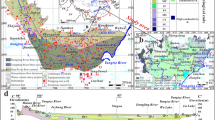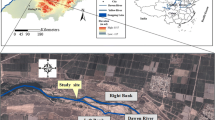Abstract
The unique relationship between hydraulic conductivity (K) and depth (D) is hardly observed because K is affected by many geologic factors. To characterize the variation of K with D in unconsolidated sediments, 820 samples were collected from eight boreholes along the Hutuo River in the direction of flow in the North China Plain (NCP). The K values of these samples were determined using the geophysical logging and grain size data, after which the K series with D for eight boreholes were divided into three components: seasonal, trend, and random components, using the random forest (RF) and time series (TS) methods. The results indicate that the stratum pressure has significant effects on the variation of K with D in the upper layers for H2, H5, H6, and H7 and in the deep layer for H1, H3, and H4. It is here concluded that K can decrease with D when the effects of sedimentary environment and random errors are eliminated. The decreasing trend component of K includes three different decay models, and its difference value shows a decreasing trend from the piedmont region and central plain to the coastal area. The conclusions drawn in this paper are crucial to understanding the dependence of K on D in unconsolidated sediments, which can provide key information for quantifying deep groundwater flow and transport.








Similar content being viewed by others
References
Bakshevskaya VA, Pozdnyakov SP (2013) Methods of modeling hydraulic heterogeneity of sedimentary formations. Water Resour 40:767–775. doi:10.1134/S0097807813070026
Barahona-Palomo M, Riva M, Sanchez-Vila X, Vazquez-Sune E, Guadagnini A (2011) Quantitative comparison of impeller-flowmeter and particle-size-distribution techniques for the characterization of hydraulic conductivity variability. Hydrogeol J 19:603–612. doi:10.1007/s10040-011-0706-5
Blaschke AP, Steiner KH, Schmalfuss R, Gutknecht D, Sengschmitt D (2003) Clogging processes in hyporheic interstices of an impounded river, the Danube at Vienna, Austria. Int Rev Hydrobiol 88(3–4):397–413. doi:10.1002/iroh.200390034
Boucekine M, Loundou A, Baumstarck K, Minaya-Flores P, Pelletier J, Ghattas B (2013) Using the random forest method to detect a response shift in the quality of life of multiple sclerosis patients: a cohort study. BMC Med Res Methodol 13:20–28. doi:10.1186/1471-2288-13-20
Cheng C, Chen X (2007) Evaluation of methods for determination of hydraulic properties in an aquifer-aquitard system hydrologically connected to a river. Hydrogeol J 15:669–678. doi:10.1007/s10040-006-0135-z
Cheng C, Song J, Chen X, Wang D (2011) Statistical distribution of streambed vertical hydraulic conductivity along the Platte River, Nebraska. Water Resour Manag 25:265–285. doi:10.1007/s11269-010-9698-5
Dong W, Chen X, Wang Z, Ou G, Liu C (2012) Comparison of vertical hydraulic conductivity in a streambed-point bar system of a gaining stream. J Hydrol 450:9–16. doi:10.1016/j.jhydrol.2012.05.037
Doro KO, Leven C, Cirpka OA (2013) Delineating subsurface heterogeneity at a loop of river Steinlach using geophysical and hydrogeological methods. Environ Earth Sci 69:335–348. doi:10.1007/s12665-013-2316-0
Jiang R, Tang W, Wu X, Fu W (2009a) A random forest approach to the detection of epistatic interactions in case-control studies. BMC Bioinf 10:S65–S78. doi:10.1186/1471-2105-10-S1-S65
Jiang XW, Wan L, Wang XS, Ge S, Liu J (2009b) Effect of exponential decay in hydraulic conductivity with depth on regional groundwater flow. Geophys Res Lett 36(24):L24402. doi:10.1029/2009GL041251.
Jiang XW, Wang XS, Wan L (2010) Semi-empirical equations for the systematic decrease in permeability with depth in porous and fractured media. Hydrogeol J 18:839–850. doi:10.1007/s10040-010-0575-3
Jung Y, Mahinthakumar G, Ranjithan R (2013) Development of a simultaneous search-based pilot point method for subsurface characterization. Stoch Environ Res Risk Assess 27:2003–2013. doi:10.1007/s00477-013-0734-x
Louis C (1974) Rock hydraulics, in rock mechanics. Springer, New York, pp. 299–387
Liu X, Feng X, Liu J, Lin L (2014) Laboratory application of laser grain-size analyzer in determining suspended sediment concentration. J Ocean Univ China 13(3):375–380. doi:10.1007/s11802-014-1973-2
Lu H (2007) A method to estimate hydraulic conductivity from bulk geochemical compositions. Environ Geology 51:1029–1041. doi:10.1007/s00254-006-0372-4
Malyutina E, Shiryaev V (2014) Time series forecasting using nonlinear dynamic methods and identification of deterministic chaos. Procedia Comput Sci 31:1022–1031. doi:10.1016/j.procs.2014.05.355
Meyerhoff S, Maxwell R (2011) Quantifying the effects of subsurface heterogeneity on hillslope runoff using a stochastic approach. Hydrogeol J 19:1515–1530. doi:10.1007/s10040-011-0753-y
Min L, Yu J, Liu C, Zhu J, Wang P (2013) The spatial variability of streambed vertical hydraulic conductivity in an intermittent river, northwestern China. Environ Earth Sci 69:873–883. doi:10.1007/s12665-012-1973-8
Pahlavan R, Toomanian N, Khormali F, Brungard C, Komaki C (2014) Updating soil survey maps using random forest and conditioned Latin hypercube sampling in the loess derived soils of northern Iran. Geoderma 232-234:97–106. doi:10.1016/j.geoderma.2014.04.036
Pliakas F, Petalas C (2011) Determination of hydraulic conductivity of unconsolidated river alluvium from permeameter tests, empirical formulas and statistical parameters effect analysis. Water Resour Manag 25(11):2877–2899. doi:10.1007/s11269-011-9844-8
Rienzner M, Gandolfi C (2014) Investigation of spatial and temporal variability of saturated soil hydraulic conductivity at the field-scale. Soil Tillage Res 135:28–40. doi:10.1016/j.still.2013.08.012
Rogiers B, Mallants D, Batelaan O, Gedeon M, Huysmans M, Dassargues A (2012) Estimation of hydraulic conductivity and its uncertainty from grain-size data using glue and artificial neural networks. Math Geosci 44:739–763. doi:10.1007/s11004-012-9409-2
Rogiers B, Winters P, Huysmans M, Beerten K, Mallants D, Gedeon M (2014) High-resolution saturated hydraulic conductivity logging of borehole cores using air permeability measurements. Hydrogeol J 22:1345–1358. doi:10.1007/s10040-014-1144-y
Rosas J, Lopez O, Missimer TM, Coulibaly K, Dehwah AH, Sesler K (2014) Determination of hydraulic conductivity from grain-size distribution for different depositional environments. Groundwater 52:399–413. doi:10.1111/gwat.12078
Ross HC, Mcelwee CD (2007) Multi-level slug tests to measure 3-D hydraulic conductivity distributions. Nat Resour Res 16:67–79. doi:10.1007/s11053-007-9034-9
Saar MO (2004) Depth dependence of permeability in the Oregon Cascades inferred from hydrogeologic, thermal, seismic, and magmatic modeling constraints. J Geophys Res: Solid Earth (1978–2012) 109 (B4). doi: 10.1029/2003JB002855
Sakata Y, Ikeda R (2013) Depth dependence and exponential models of permeability in alluvial-fan gravel deposits. Hydrogeol J 21:773–786. doi:10.1007/s10040-013-0961-8
Shao X, Yao F, Zhang J, Li X (2013) Analysis of drought in north Chian based on evapotranspiration drought index. Meteorological Monthly 39(9):1154–1162. doi:10.7519/j.issn.1000-0526.2013.09.010
Shruthi RBV, Kerle N, Jetten V, Stein A (2014) Object-based gully system prediction from medium resolution imagery using random forests. Geomorphology 216:283–294. doi:10.1016/j.geomorph.2014.04.006
Song J, Chen X, Cheng C, Summerside S, Wen F (2007) Effects of hyporheic processes on streambed vertical hydraulic conductivity in three rivers of Nebraska. Geophys Res Lett 34(7):L07409. doi:10.1029/2007GL029254
Song J, Chen X, Cheng C, Wang D, Wang W (2010) Variability of streambed vertical hydraulic conductivity with depth along the Elkhorn River, Nebraska, USA. Chin Sci Bull 55:992–999. doi:10.1007/s11434-009-0640-2
Soupios PM, Kouli M, Vallianatos F, Vafidis A, Stavroulakis G (2007) Estimation of aquifer hydraulic parameters from surficial geophysical methods: a case study of Keritis Basin in Chania (Crete–Greece). J Hydrol 338(1):122–131. doi:10.1016/j.jhydrol.2007.02.028
Tijani MN, Nton ME (2009) Hydraulic, textural and geochemical characteristics of the Ajali formation, Anambra Basin, Nigeria: implication for groundwater quality. Environ Geol 56:935–951. doi:10.1007/s00254-008-1196-1
Urish DW (1981) Electrical resistivity–hydraulic conductivity relationships in glacial outwash aquifers. Water Resour Res 17(5):1401–1408. doi:10.1029/WR017i005p01401
Verbesselt J, Hyndman R, Newnham G, Culvenor D (2010) Detecting trend and seasonal changes in satellite image time series. Remote Sens Environ 114:106–115. doi:10.1016/j.rse.2009.08.014
Veronesi F, Hurni L (2014) Random Forest with semantic tie points for classifying landforms and creating rigorous shaded relief representations. Geomorphology 224:152–160. doi:10.1016/j.geomorph.2014.07.020
Vienken T, Dietrich P (2011) Field evaluation of methods for determining hydraulic conductivity from grain size data. J Hydrol 400:58–71. doi:10.1016/j.jhydrol.2011.01.022
Wojnar AJ, Mutiti S, Levy J (2013) Assessment of geophysical surveys as a tool to estimate riverbed hydraulic conductivity. J Hydrol 482:40–56. doi:10.1016/j.jhydrol.2012.12.018
Wu M, Wu J, Liu J, Wu J, Zheng C (2015) Effect of groundwater quality on sustainability of groundwater resource: a case study in the North China plain. J Contam Hydrol 179:132–147. doi:10.1016/j.jconhyd.2015.06.001
Xing L, Guo H, Wei L, Zhang Y, Hou C, Li R, Wang Y (2012) Evolution feature and genesis of fluoride groundwater in shallow aquifer from North China plain. J Earth Sci Environ 34:57–67. doi:10.3969/j.issn.1672-6561.2012.04.008
Zhao P, Shao M, Wang T (2010) Spatial distributions of soil surface-layer saturated hydraulic conductivity and controlling factors on dam farmlands. Water Resour Manag 24:2247–2266. doi:10.1007/s11269-009-9550-y
Acknowledgments
This work was supported by the Geological Survey Projects Foundation of Institute of Hydrogeology and Environmental Geology (G201503, G201605, and SK201504), China Postdoctoral Science Foundation (2015 M571658), and National Natural Science Foundation of China (41502248).
Author information
Authors and Affiliations
Corresponding author
Rights and permissions
About this article
Cite this article
Ma, R., Shi, J., Zhang, Y. et al. Variation of hydraulic conductivity with depth in the North China plain. Arab J Geosci 9, 571 (2016). https://doi.org/10.1007/s12517-016-2597-1
Received:
Accepted:
Published:
DOI: https://doi.org/10.1007/s12517-016-2597-1




